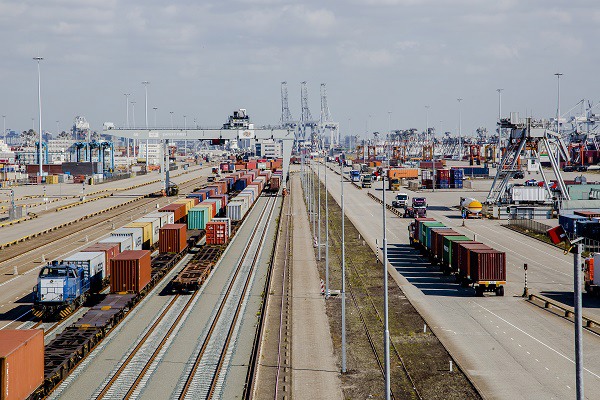Year after year, container ships are breaking records with the number of containers they can carry onboard. But bigger doesn’t always mean faster. The Hutchison Ports ECT Rotterdam (ECT) online platform aims to change that.

ECT Delta terminal
Depending on the container ship’s call size, the number of containers it must load and offload at any given en-route terminal can sometimes take up to 72 hours. It could be that your container’s unloaded first or at the very end. It’s getting increasingly important for clients to know exactly when to expect their loads. Certainly when it comes to high-value, perishable goods like fruit and vegetables.
Following your container
An online platform called MyTerminal has, therefore, been developed. It gives an overview of a container’s status when it arrives at one of the ECT terminals. These are the Maasvlakte, Euromax, and Delta terminals, all in Rotterdam, the Netherlands. “Clients can use this platform to get updates about their containers,” says Willemien Akerboom, ECT’s product manager.
“This begins even before the ship’s arrival. We can give an Estimated Time of Arrival (ETA) while the vessel’s still far out at sea. This ETA is updated in realtime, and the closer the cargo gets to harbor, the more accurate the ETA. Once the ship docks, we can provide insight into the container’s estimated unloading time. That estimation depends on the ship’s call size at port and where the container’s stowed onboard. Sometimes it’s less than 24 hours, but it could take up to three days.”
“We relay all this information to the platform in realtime. So, clients can quickly see when their container’s available. Besides offloading, MyTerminal also reports any delays that could affect the container. For instance, customs officials might want to inspect the contents. The app will indicate this. You can also set notifications on the platform if you want to keep up to speed with your container’s status,” Willemien says.
MyTerminal’s was developed in response to a demand from the fruit and vegetable sector. Companies wanted to be able to see the status of containers visible in realtime. “If there’s a sector that has a great need to know precisely when a container will be available, it’s this one. The contents of the frequently used reefer containers are often of high value. And so, it’s important to know their status. We relay information about the container’s status, not other variables like its temperature. Specialized service providers do that.”

My Terminal interface
Security
The data used comes directly from the terminal itself. So, the realtime information’s always up-to-date. Sharing data is becoming increasingly important in the supply chain. “We gladly share this data, but only we know with whom it’s being re-shared,” continues Willemien. “It must be done securely, and the correct authorization must have been arranged. We took this into account from the get-go. We also pumped a lot of money into the platform’s digital security. So, for example, to access the data, you need a validated account.”
Through flow
The MyTerminal platform is part of a larger service package. “Not only does this app ensure a smoother flow because container removal can be better planned. We offer other services too. There’s a customs container scan at the terminal. Containers can be scanned during the terminal process. To guarantee the container’s inside temperature, the reefers are plugged into a specialized company that’s affiliated with us. That’s done after offloading,” explains Akerboom.
“Delta Reefer Care workers continually monitor the reefer. They do so to guarantee that products arrive at the buyer in perfect condition.” ECT terminals currently have ample reefer plugs. If necessary, extra sockets can be added, as was the case in March. At the terminal, there’s a peak in reefer container numbers between February and mid-May. A second, smaller peak follows in September. “But the coronavirus outbreak caused a drop in the usual peak. So, it ended in Mid-April already, instead of mid-May.”

Port of Rotterdam
Cooperation
Recently more of these platforms that give clients an overview of their container’s status seem to be appearing on the market. Not only at the terminal but over the whole logistical process. From when the products enter the containers up to when they’re standing in the client’s warehouse. “We see parties entering the market that focus solely on this digital product,” says the product manager.
“I wouldn’t call it competition. We, in fact, would rather seek cooperation with these parties since we, as a terminal, can, conditionally, offer the correct data. This information’s needed for realtime insight into a container’s status throughout the chain. We’d prefer to help bring such a digital service provider to a specific port’s attention. These services, after all, offer added value. They also ensure that there’s more transparency in the logistics chains,” Willemien concludes.
More information Hutchison Port ECT
Hutchison Port ECT
T: +31 (0)181 – 278088
customerservice@ect.nl
www.ect.nl
